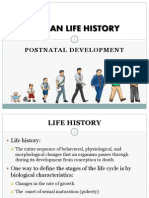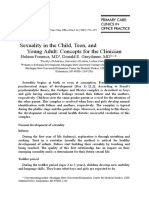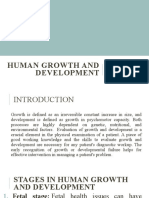Adolescent Development Article
Adolescent Development Article
Uploaded by
api-308979239Copyright:
Available Formats
Adolescent Development Article
Adolescent Development Article
Uploaded by
api-308979239Original Title
Copyright
Available Formats
Share this document
Did you find this document useful?
Is this content inappropriate?
Copyright:
Available Formats
Adolescent Development Article
Adolescent Development Article
Uploaded by
api-308979239Copyright:
Available Formats
Chapter 1
ADOLESCENT GROWTH AND DEVELOPMENT
Jamie Stang and Mary Story
Biological, psychosocial and cognitive changes that begin during puberty and continue throughout
adolescence directly affect nutritional status and nutrient needs. Adolescents experience dramatic
physical growth and development during puberty, which in turn appreciably increases their
requirements for energy, protein, and many vitamins and minerals. Adolescents also experience
significant changes in their ability to assess and comprehend complex situations and information
and in their desire to become independent, unique individuals. The increased need for energy and
nutrients among adolescents, combined with increasing financial independence, increasing need for
autonomy when making food choices, and immature cognitive abilities, places adolescents at
nutritional risk. Therefore, it is vital that health care providers who provide nutrition education and
counseling have a thorough understanding of adolescent physical and psychosocial growth and
development.
NORMAL PHYSICAL GROWTH AND DEVELOPMENT
The beginning of biological growth and development during adolescence is signified by the onset of
puberty, which is often defined as the physical transformation of a child into an adult. A myriad of
biological changes occur during puberty including sexual maturation, increases in height and
weight, completion of skeletal growth accompanied by a marked increase in skeletal mass, and
changes in body composition. The succession of these events during puberty is consistent among
adolescents, however, there may be a great deal of deviation in the age of onset, duration, and
tempo of these events between and within individuals. For this reason, adolescents of the same
chronological age can vary greatly in physical appearance. This has direct relevance for the
nutrition requirements of adolescents. A 13-year-old male who has nearly completed the linear
growth spurt associated with puberty and has experienced significant muscular development will
have remarkably different energy and nutrient needs than those of a 13-year-old male who has not
yet experienced puberty. Consequently, sexual maturation should be used to assess the extent of
biological growth and development and the individual nutritional needs of adolescents in place of
chronological age.
Sexual Maturation Rating (SMR), also known as Tanner Staging, is based upon a scale of secondary
sexual characteristics that permits health professionals to gauge the degree of pubertal maturation
that has occurred among adolescents, regardless of chronological age (Table 1). SMR is based on
the appearance of pubic hair, the development of breasts, and the occurrence of menarche among
females; and on the degree of testicular and penile development and the appearance of pubic hair
among males. SMR stage 1 corresponds with prepubertal growth and development, while stages 2-5
indicate the progression of puberty. By SMR stage 5, sexual maturation has been completed. Sexual
maturation correlates remarkably well with linear growth, changes in weight and body composition,
1
and hormonal changes.
Stang J, Story M (eds) Guidelines for Adolescent Nutrition Services (2005)
http://www.epi.umn.edu/let/pubs/adol_book.shtm
GUIDELINES FOR ADOLESCENT NUTRITION SERVICES
TABLE 1
Sexual Maturity Rating
GIRLS
Breast Development
Stage
Pubic Hair Growth
Prepubertal; nipple elevation only
Prepubertal; no pubic hair
Small, raised breast bud
Sparse growth of hair along labia
General enlargement of raising of breast and
areola
Pigmentation, coarsening and
curling, with an increase in amount
Further enlargement with projection of areola and
nipple as secondary mound
Hair resembles adult type, but not
spread to medial thighs
Mature, adult contour, with areola in same contour
as breast, and only nipple projecting
Adult type and quantity, spread to
medial thighs
BOYS
Genital Development
Stage
Pubic Hair Growth
Prepubertal; no change in size or proportion of
testes, scrotum and penis from early childhood
Prepubertal; no pubic hair
Enlargement of scrotum and testes; reddening
and change in texture in skin of scrotum; little or
no penis enlargement
Sparse growth of hair at base of
penis
Increase first in length then width of penis; growth
of testes and scrotum
Darkening, coarsening and
curling, increase in amount
Enlargement of penis with growth in breadth and
development of glands; further growth of testes
and scrotum, darkening of scrotal skin
Hair resembles adult type, but not
spread to medial thighs
Adult size and shape genitalia
Adult type and quantity, spread to
medial thighs
Source: Data from Tanner JM. Growth at adolescence. Oxford: Blackwell Scientific Publications, 1962.
Figure 1 depicts the occurrence of the linear growth spurt and the onset of menarche relative to the
occurrence of secondary sexual characteristics among females during puberty. The first signs of
puberty among females are the development of breast buds and sparse pubic hair, which occurs
between ages 8-13 on average (SMR stage 2). The onset of menstruation occurs 2-4 years after the
initial appearance of breast buds and pubic hair, usually during SMR stage 4. The average age of
menarche is 12.4 years for females in the United States, but the age at which it occurs is highly
variable; menarche can occur as early as 9 or 10 years of age or as late as 17 years of age. The onset
of menstruation may be delayed in females who restrict their caloric intake and body weight or who
are competitive athletes.
Chapter 1. Adolescent Growth and Development
FIGURE 1
Sequence of Physiological Changes During Puberty in Females
Height Spurt
9.5 - 14.5 yrs
Menarche
Breast
SMR
2 3
10 - 16.5
yrs
4
5
8 13
SMR
Pubic Hair
8 14
8
10
11
12
13
14
15
16
17
Age (yrs)
*An average female is represented: the range of ages within which some of the events may occur is given by
the figures placed directly below them.
Source: Adapted from Tanner JM. Growth at adolescence. Oxford: Blackwell Scientific Publications; 1962. Reprinted with
permission. http://www.blackwell-synergy.com/
There appear to be ethnic and racial differences in the initiation of sexual maturation among US
females. Research indicates that African American girls may enter puberty earlier than their white
peers. Among females in a large study, 48% of African American girls had reached SMR stage 2 by
age 8, compared to 15% of their white peers.2 Among African American girls in that study, the
average age of initial breast development was 8.8 years, while it was 9.9 years for white females.
Pubic hair growth began at age 8.7 years in African American females, occurring almost 2 years
earlier than their white peers. Menarche, however, occurred at approximately the same time in both
groups 12.2 years for African American and 12.8 for white females. The findings of that study
suggest that, on average, puberty may begin earlier and last longer among African American
females than among white females.
Testicular enlargement and change in scrotal coloring are the first signs of puberty among males,
usually occurring between 10.5 and 14.5 years of age (11.6 on average) during SMR stage 2
(Figure 2). The development of pubic hair is also observed during SMR stage 2. Testicular
enlargement starts between 9.5 and 13.5 years of age in most males (SMR 2 to 3), concluding
between the ages of 12.7 and 17 (SMR stage 5). Spermarche, or the onset of sperm production,
occurs at approximately age 14 among males. The onset of puberty among males is highly variable,
thus nutritional needs of male adolescents of the same chronological age are also highly variable.
The linear growth spurt begins most commonly during SMR stage 2 in females, between 9.5 and
14.5 years of age. Peak velocity of linear growth takes place at the end of SMR stage 2 and during
SMR stage 3, approximately 6 to 12 months prior to menarche. It is estimated that 15 to 25% of
GUIDELINES FOR ADOLESCENT NUTRITION SERVICES
3
final adult height is gained during the growth spurt of puberty. The average increase in height is
estimated at 8.24 in (20.5 cm), with a range of 2-10 in (5-25 cm) seen in most females.3,4 During the
peak of the linear growth spurt, females gain roughly 3.5 in (8 - 9 cm) per year. The linear growth
spurt lasts 24 to 26 months, ceasing by 16.5 years of age in most females. Some adolescent females
experience small increments of growth past age 19 years, however. Linear growth may be delayed
or slowed among females who severely restrict their caloric intake.
Peak velocity of linear growth occurs later in puberty among males than among females, most often
during SMR stage 4, at 14.4 years of age on average. The greatest rates of linear growth among
males coincide with or closely follow testicular development and the growth of facial hair.
Adolescent males experience increases in height of 4-12 in (10-30 cm) during puberty, with an
average of 2.8 - 4.8 in (7 - 12 cm) attained each year.3,4 Linear growth continues throughout
adolescence, at an increasingly slower rate, ceasing between 18 and 21 years of age.
FIGURE 2
Sequence of Physiological Changes During Puberty in Males
Height Spurt
10.5 16.0
13.5 17.5
Penis
10.5 14.5
12.5 16.5
Testes
9.5 13.5
2
SMR
Pubic Hair
13.5 17.0
3
8-14
8
10
11
12
13.5 17.0
13
14
15
16
17
Age (yrs)
An average male is represented: the range of ages within which each event charted may begin and end is
given by the figures placed directly below its start and finish.
Source: Adapted from Tanner JM. Growth at adolescence. Oxford: Blackwell Scientific Publications; 1962. Reprinted with
permission. http://www.blackwell-synergy.com/
Approximately half of maximal adult bone mass is accumulated during adolescence. By 18 years of
1
age, more than 90% of adult skeletal mass has been accrued. Many factors play a role in the
accrual of bone mass including genetic potential, hormonal fluctuations, weight bearing exercise,
cigarette smoking, alcohol consumption, and intakes of vitamins and minerals such as vitamin D,
calcium, phosphorous, boron and iron. It should be noted that more than one-third of adult bone
mass is thought to accrue during and immediately following puberty.5,6 After adult height is
achieved, the accumulation of significant amounts of additional bone mass is unlikely.
Chapter 1. Adolescent Growth and Development
Changes in Weight and Body Composition
Approximately half of adult ideal body weight is gained during adolescence. Peak weight gain
follows the linear growth spurt by 3 to 6 months in females and by approximately 3 months in
males. Girls will gain approximately 18.3 lb (8.3 kg) per year during peak rates of weight gain,
(12.5 years of age on average).3,4 Average weight gains during puberty among females are between
15-55 lb (7-25 kg), with a mean gain of 38.5 lb (17.5 kg). Weight gain slows around the time of
menarche, but will continue into late adolescence. Adolescent females may gain as much as 14 lb
(6.3 kg) during the latter half of adolescence. 3,4
Adolescent males gain an average of 20 lb (9 kg) per year during puberty.3,4 Overall, male teens
gain 15-65 lb (7-30 kg) during puberty, with a mean gain of 52.2 lb (23.7 kg).3,4
Body fat levels decrease among males during adolescence, dropping to an average of 12% body fat
by the end of puberty. Body composition changes more significantly among females during puberty.
The average lean body mass of teen females falls from 80%-74% while average body fat levels
increase from 16%-27% by the end of adolescence. Females experience a 120% increase in body fat
during puberty. On average, teen females acquire approximately 2.5 lb (1.14 kg) of body fat mass
each year during puberty.7
While the accretion of body fat mass is a normal, physiologically essential process, adolescent
females often view it with negativity. Weight dissatisfaction is widespread among teenage females,
leading to an increased risk of health-compromising behaviors such as excessive caloric restriction,
frequent dieting, use of diet pills or laxatives, severe body image distortions and eating disorders.
NORMAL PSYCHOSOCIAL AND COGNITIVE DEVELOPMENT
During adolescence teens develop a stronger recognition of their own personal identity, including
recognition of a set of personal moral and ethical values, and greater perception of feelings of selfesteem or self worth. Psychosocial and cognitive development is best understood when divided into
three periods: early adolescence (11-14 years), middle adolescence (15-17 years), and late
adolescence (18-21 years). Each of these distinct periods of development is marked by the mastery
of new emotional, cognitive and social skills (Table 2).
TABLE 2
Psychosocial Processes and the Substages of Adolescent Development
Substage
Early
adolescence
Emotionally Related
Adjustment to a new
body image, adaptation
to emerging sexuality
Cognitively Related
Concrete thinking; early
moral concepts
Socially Related
Strong peer effect
Middle
adolescence
Establishment of
emotional separation
from parents
Emergence of abstract
thinking, expansion of verbal
abilities and conventional
morality; adjustment to
increased school demands
Increased health risk
behavior; sexual interests
in peers; early vocational
plans
Late
adolescence
Establishment of a
personal sense of
identity; further
separation from parents
Development of abstract,
complex thinking;
emergence of postconventional morality
Increased impulse
control; emerging social
autonomy; establishment
of vocational capability
Source: Reprinted from Ingersoll GM, Psychological and social development. In: McAnarney E. Textbook of adolescent
medicine 1992, with permission from Elsevier.
GUIDELINES FOR ADOLESCENT NUTRITION SERVICES
Psychosocial Development
Adolescents experience dramatic biological changes related to puberty; these biological changes can
significantly affect psychosocial development. An increased awareness of sexuality and a heightened
preoccupation with body image are fundamental psychosocial tasks during adolescence. Dramatic
changes in body shape and size can cause a great deal of ambivalence among adolescents, especially
among females, leading to the development of poor body image and eating disturbances or disorders
if not addressed by family or health care professionals. Similarly, a perceived delay in sexual
maturation and biological development, especially among males, may lead to the development of
poor body image and lowered self-esteem. It is imperative that health professionals who work with
adolescents have a clear understanding of how normal psychosocial and cognitive development
relate to biological growth and development, and are able to appreciate how these processes affect
nutritional intake and status.
Peer influence is a dominant psychosocial issue during adolescence, especially during the early
stages. Young teens are highly cognizant of their physical appearance and social behaviors, seeking
acceptance within a peer group. The desire to conform can influence food intakes among teens. Focus
groups comprised of adolescent females have revealed that food is divided into two classification
groups: junk foods and healthy foods.8 Eating junk foods, according to these focus groups, was
associated with being with friends, having fun, gaining weight, and guilt, whereas eating healthy
foods was associated with family, family meals, and home life. Obviously, teens adopt or develop
food preferences and make food choices based on associations with feelings of being accepted and
having fun with peers and may use food as a way to exert independence from families and parents.
The broad chronological age range during which biological growth and development begins and
advances can become a significant source of personal dissatisfaction for many adolescents as they
struggle to conform to their peers. Males who enter puberty at a later age may consider themselves to
be late bloomers, and may feel physically inferior to their peers who mature earlier. This sense of
dissatisfaction may lead to the use of anabolic steroids and other supplements in an effort to increase
linear growth and muscle development and to gain weight. Such dissatisfaction can also lead to
markedly reduced self-esteem. For females, however, it is often early maturation that is associated
with poor body image, poor self-esteem, frequent dieting, and, possibly, disturbed or disordered
eating behaviors. Early maturing female teens are also at increased risk for engaging in other
unhealthy behaviors such as smoking, alcohol consumption, and early sexual intercourse.9-11 Young
adolescents should be educated on normal variations in initiation and progression of biological
growth and development in an effort to facilitate the development of a positive self-image and body
image and to reduce the likelihood of early initiation of health compromising behaviors.
Cognitive Development
The early stage of adolescence is a time of great cognitive development. At the beginning of
adolescence, cognitive abilities are dominated by concrete thinking, egocentrism, and impulsive
behavior. The ability to engage in abstract reasoning is not highly developed in most young teens,
limiting their capacity to comprehend nutrition and health relationships. Young adolescents also
lack the skills necessary to problem solve in an effort to overcome barriers to behavior change and
the ability to appreciate how current behaviors can affect future health status.
Middle adolescence is characterized by growth in emotional autonomy and increasing detachment
from family. The bulk of physical growth and development is completed during this stage, however
body image concerns may continue to be a source of trepidation, especially among males who are
Chapter 1. Adolescent Growth and Development
late to mature and females who have experienced great changes in body composition and size.
Conflicts over personal choice, including food choices, become increasingly common during this
stage of adolescence. Peer groups become more important than family and their influence with
regard to making food choices peaks. Coinciding with the increased importance of peer acceptance,
the initiation of health compromising behaviors such as smoking, alcohol consumption, using street
drugs, and engaging in sexual activities often occurs during middle adolescence. Teens may
consider themselves invincible and often still display impulsive behaviors.
Abstract reasoning skills begin to emerge among most teens during middle adolescence, however,
these skills may not be highly developed. Adolescents will often regress to concrete thinking skills
when faced with overwhelming emotions or stressful situations. Teens start to comprehend the
relationship between existing health behaviors and future health status but their desire to fit in with
peers may make it difficult for adolescents to make health related choices based upon knowledge
rather than peer pressure.
The late stage of adolescence is characterized by the development of a strong personal identity.
Biological growth and development has concluded among most teens and body image issues are
less common. Older adolescents are able to manage increasingly sophisticated social situations, are
able to suppress impulsive behaviors, and are less affected by peer pressure. Economic and
emotional dependence upon family is markedly decreased and conflict over personal issues, such as
food choices, also decreases. Relationships with a single individual become more influential than
those with a group of peers as a stronger sense of personal identity emerges.
The expansion of abstract reasoning skills continues to occur during late adolescence, which assists
teens in developing an ability to comprehend how current health behaviors affect long-term health
status. This is an especially important skill for adolescent females who plan to have children or who
become pregnant during late adolescence. Older teens are now capable of learning problem solving
skills that can assist them in overcoming barriers to behavior change.
IMPLICATIONS FOR NUTRITION INTERVENTION
Because adolescence is a time of tremendous biological, psychosocial and cognitive growth and
development, nutrition interventions need to be tailored to the developmental level of each
individual adolescent. Health professionals should allow adequate time during the first session with
a teen to determine his/her degree of biological maturity and level of cognitive development. These
characteristics should be used to determine the individual nutritional needs and the type of
educational messages that are given when counseling the adolescent.
REFERENCES
1.
Gong EJ, Heald FP. Diet, nutrition and adolescence. In: Shils ME, Olson JA, Shike M, eds. Modern
nutrition in health and disease. Philadelphia: Lea & Febiger; 1994;759-769.
2.
Herman-Giddens ME, Slora EJ, Wasserman RC, Bourdony CJ, Bhapkar MV, Koch GG, et al. Secondary
sexual characteristics and menses in young girls seen in office practice: a study from the pediatric
research in office settings network. Pediatrics 1997;99(4):505-511.
3.
Barnes HV. Physical growth and development during puberty. Med Clin North Am 1975;59:1305-1317.
4.
Wong DL, Wilson D, Whaley LF. Whaley & Wong's nursing care of infants and children. 5th ed. St.
Louis: Mosby; 1995.
GUIDELINES FOR ADOLESCENT NUTRITION SERVICES
5.
Bonjour J, Theintz G, Buchs B, Slosman D, Rizzoli R. Critical years and stages of puberty for spinal and
femoral bone mass accumulation during adolescence. J Clin Endocrinol Metab 1991;73:555-563.
6.
Slemenda CW, Reister TK, Hui SL, Miller JZ, Christian JC, Johnston Jr CC. Influence on skeletal
mineralization in children and adolescents: Evidence for varying effects of sexual maturation and
physical activity. J Pediatr 1994;125:201-207.
7.
Frisch RE. Fatness, puberty and fertility: The effects of nutrition and physical training on menarche and
ovulation. In: Brooks-Gunn J, Peterson AC, eds. Girls at puberty: biological and psychosocial
perspectives. New York: Plenum Press; 1983;29-49.
8.
Barr S. Associations of social and demographic variables with calcium intakes in high school students. J
Am Diet Assoc 1994;94:260-266, 269.
9.
Attie I, Brooks-Gunn J. Development of eating problems in adolescent girls: a longitudinal study. Dev
Psychol 1989;25:70-79.
10. Killen JD, Hayward C, Litt I, Hammer LD, Wilson DM, Miner B, et al. Is puberty a risk factor for eating
disorders? Am J Dis Child 1992;146(3):323-325.
11. Wilson DM, Killen JD, Hayward C, Robinson TN, Hammer LD, Kraemer HC, et al. Timing and rate of
sexual maturation and the onset of cigarette and alcohol use among teenage girls. Arch Pediatr Adolesc
Med 1994;148(8):789-795.
You might also like
- High SchoolerDocument67 pagesHigh SchoolerJulie Ann Gines100% (2)
- NUTR 323 Chapter 14 NotesDocument27 pagesNUTR 323 Chapter 14 NotesMon LuffyNo ratings yet
- Ap Cell Division and Reproduction MCDocument6 pagesAp Cell Division and Reproduction MCapi-522349089No ratings yet
- Rubric For Human Impact ProjectDocument2 pagesRubric For Human Impact ProjectJohn OsborneNo ratings yet
- Handout On Adolescent MedicineDocument50 pagesHandout On Adolescent MedicineReymart FernandezNo ratings yet
- Bahan 4Document7 pagesBahan 4Bayu SetiawanNo ratings yet
- Puberty StageDocument2 pagesPuberty StageXielalah Sai SoonNo ratings yet
- Paeds G4Document17 pagesPaeds G4samakayigrace808No ratings yet
- Growth: DR Omar Ali Nafi MRCP Mutah UniversityDocument66 pagesGrowth: DR Omar Ali Nafi MRCP Mutah UniversityDr-Sulaiman Bani Abdel-rahmanNo ratings yet
- Growth and Development: Basic Tenets of Growth PatternDocument13 pagesGrowth and Development: Basic Tenets of Growth PatternAbbas ali HarbiNo ratings yet
- Human Life History: Postnatal DevelopmentDocument49 pagesHuman Life History: Postnatal DevelopmentrobiahanitaNo ratings yet
- Child and Adolscent ReportDocument20 pagesChild and Adolscent ReportAlie MandiNo ratings yet
- Development During AdolescenceDocument38 pagesDevelopment During AdolescenceSheeraz ShaikhNo ratings yet
- Sexuality in The Child, Teen, and Young Adult: Concepts For The ClinicianDocument18 pagesSexuality in The Child, Teen, and Young Adult: Concepts For The ClinicianAna Yris Silvestre SosaNo ratings yet
- Adolescence (The High School Learner)Document28 pagesAdolescence (The High School Learner)KD AlquizarNo ratings yet
- What Is PubertyDocument3 pagesWhat Is PubertyMonday Verdejo100% (1)
- Review of LiteratureDocument51 pagesReview of Literaturenawahib aliNo ratings yet
- Devpsy Chapter 10 PubertyDocument66 pagesDevpsy Chapter 10 PubertymnbleosalaNo ratings yet
- MCN 313 1HDocument4 pagesMCN 313 1HJon EricNo ratings yet
- 09 - Chapter 1Document33 pages09 - Chapter 1Joma Pauline EmbestroNo ratings yet
- 10 Constitutional Delay of Growth and PubertyDocument19 pages10 Constitutional Delay of Growth and PubertyPratita Jati PermatasariNo ratings yet
- PubertyDocument26 pagesPubertyoctvipinNo ratings yet
- Module 9 Adolescence Physical Cognitive and Socioemotional DevelopmentDocument23 pagesModule 9 Adolescence Physical Cognitive and Socioemotional DevelopmenttopakinNo ratings yet
- Characteristics of Adolescence08Document82 pagesCharacteristics of Adolescence08Frances Daloraya100% (1)
- The Adolescent and FamilyDocument78 pagesThe Adolescent and FamilyAikoSnowNo ratings yet
- Methods of Studying GrowthDocument112 pagesMethods of Studying GrowthEmad Ahmad Anis67% (3)
- Physical GrowthDocument5 pagesPhysical GrowthrevgandaNo ratings yet
- PedepDocument12 pagesPedepZyanne RocaforNo ratings yet
- Psycological DevelopmentDocument3 pagesPsycological DevelopmentShafeeu MuhammadNo ratings yet
- Puberty: A Guide For Teenage Boys And Their ParentsFrom EverandPuberty: A Guide For Teenage Boys And Their ParentsNo ratings yet
- PubertyDocument14 pagesPubertyAdelle SmithNo ratings yet
- Growth SpurtDocument35 pagesGrowth SpurtNeeraj AroraNo ratings yet
- The Sexual SelfDocument16 pagesThe Sexual SelfDaniella BonacheNo ratings yet
- Puberty: Physical Changes Associated With PubertyDocument12 pagesPuberty: Physical Changes Associated With PubertyAnizkha Mitternacht100% (2)
- Medical Rogress: Stature Physiology andDocument12 pagesMedical Rogress: Stature Physiology andramadhanuNo ratings yet
- Adolesecent AgeDocument42 pagesAdolesecent Agecyrilsarmiento9100% (1)
- Physical Development of High School LearnersDocument27 pagesPhysical Development of High School LearnersyoonglespianoNo ratings yet
- Growth and Development 2-1Document28 pagesGrowth and Development 2-1Linus PuleNo ratings yet
- Child Growth & DevelopmentDocument98 pagesChild Growth & DevelopmentJevin Stivie CialyNo ratings yet
- 1 PubertyDocument15 pages1 PubertyNandha KumarNo ratings yet
- Tanner, J. Issues and Advances in Adolescent Growth and Development. J. Adolesc. Health Care 1987, 8, 470-478Document1 pageTanner, J. Issues and Advances in Adolescent Growth and Development. J. Adolesc. Health Care 1987, 8, 470-478Daniela DaňováNo ratings yet
- Unit 1Document6 pagesUnit 1Vinayak PlNo ratings yet
- Development During Puberty and AdolescentDocument10 pagesDevelopment During Puberty and AdolescentjezzgermoNo ratings yet
- Physical/Biological Changes in Human Growth: Group 1Document13 pagesPhysical/Biological Changes in Human Growth: Group 1Ariessa Delos Santos100% (1)
- Adolescence: 1. Change in HeightDocument15 pagesAdolescence: 1. Change in HeightVijay KumarNo ratings yet
- Assignment No.1 MidtermDocument1 pageAssignment No.1 MidtermNoriel CodoyNo ratings yet
- Physical Development of High School LearnersDocument49 pagesPhysical Development of High School LearnersDiana Garcia SaclutiNo ratings yet
- AdolescenceDocument2 pagesAdolescenceMarrian Bonifacio GamboaNo ratings yet
- Development Task Summary Puberty Is The Starting Point of Adolescence and Is Associated With A Great Variety of SomaticDocument1 pageDevelopment Task Summary Puberty Is The Starting Point of Adolescence and Is Associated With A Great Variety of SomaticJenu Chemie IriganNo ratings yet
- Fisiologi Remaja (Dr. Mustofa)Document17 pagesFisiologi Remaja (Dr. Mustofa)Mohammad Rezza RizaldiNo ratings yet
- Sexual MaturationDocument15 pagesSexual MaturationNORHAMIDAH AYUNANNo ratings yet
- Module - 24 Physical Development of High School LearnersDocument14 pagesModule - 24 Physical Development of High School LearnersArabelle PazNo ratings yet
- Adolescent Growth and DevelopmentDocument10 pagesAdolescent Growth and DevelopmentYoko YogeshNo ratings yet
- Theories Factors Affecting Growth and DevelopmentDocument73 pagesTheories Factors Affecting Growth and DevelopmentYasmeen Jaffer100% (1)
- Chap 6 - AdolescenceDocument11 pagesChap 6 - AdolescenceAlthea YabutNo ratings yet
- Puberty: Normal Physiology (Brief Overview)Document35 pagesPuberty: Normal Physiology (Brief Overview)aisyafikritamaNo ratings yet
- Human Growth and DevelopmentDocument25 pagesHuman Growth and DevelopmentMac Paul Alariao100% (1)
- Precocious Puberty - Background, Pathophysiology, EpidemiologyDocument6 pagesPrecocious Puberty - Background, Pathophysiology, EpidemiologyOderci FilhoNo ratings yet
- Biological Development in Adolescent MalesDocument2 pagesBiological Development in Adolescent MalesrobertlordNo ratings yet
- Physical SelfDocument4 pagesPhysical Selfjayrhongarcia141No ratings yet
- Ontogenesis of Man: From Conception to Adulthood and to His Final DestinationFrom EverandOntogenesis of Man: From Conception to Adulthood and to His Final DestinationNo ratings yet
- Norma Lateralis: SkullDocument4 pagesNorma Lateralis: SkullJack Marlow0% (1)
- Energy VampiresDocument53 pagesEnergy VampiresAnonymous fO8xe7rMyA100% (4)
- CloningDocument46 pagesCloningyolandatyasNo ratings yet
- BRN PS EngDocument44 pagesBRN PS EngStewart Kuda ChirewoNo ratings yet
- The Passive - Present Continuous 2 (Transformations)Document2 pagesThe Passive - Present Continuous 2 (Transformations)Donia ShadyNo ratings yet
- Classification of Bacteriocins From Gram-Positive - 240516 - 123512Document25 pagesClassification of Bacteriocins From Gram-Positive - 240516 - 123512Yassine El-HAJJAJINo ratings yet
- ASO PathologyDocument58 pagesASO PathologyLloyd San PedroNo ratings yet
- All About CellsDocument44 pagesAll About CellsRizahNo ratings yet
- Guava LeavesDocument3 pagesGuava LeavesAmer Mohammed AliNo ratings yet
- Food Microbiology Laboratory For The Food Science Student: Cangliang Shen Yifan ZhangDocument164 pagesFood Microbiology Laboratory For The Food Science Student: Cangliang Shen Yifan ZhangQonita Rachmah100% (3)
- Laboratory Manual in HISTOLOGYDocument3 pagesLaboratory Manual in HISTOLOGYRIA ALEJANDRONo ratings yet
- Species Composition, Commercial Landings, Distribution and Some Aspects of Biology of Shark (Class Pisces) of Pakistan Mediumsized Demersal SharksDocument23 pagesSpecies Composition, Commercial Landings, Distribution and Some Aspects of Biology of Shark (Class Pisces) of Pakistan Mediumsized Demersal SharksaleshbahjamilNo ratings yet
- Invisible Friends - Contents and Sample ChapterDocument22 pagesInvisible Friends - Contents and Sample ChapterPelagic PublishingNo ratings yet
- Clinical Data Collection ToolDocument3 pagesClinical Data Collection ToolkatiegracemcleodNo ratings yet
- LFSC 2020 Gr10 Question Paper Nov Dec Mopani East District Test 1 of 2Document10 pagesLFSC 2020 Gr10 Question Paper Nov Dec Mopani East District Test 1 of 2developing habit and lifestyle of praise and worshNo ratings yet
- Certificate of Analysis: Print DateDocument2 pagesCertificate of Analysis: Print DateChristian SF100% (1)
- Taxonomy and Classification of BacteriaDocument52 pagesTaxonomy and Classification of BacteriaNtobi ThomasNo ratings yet
- Final U6 p2 2010Document6 pagesFinal U6 p2 2010Cindy ChuahNo ratings yet
- FACE 2 Years Advanced Orthodontics ProgramDocument9 pagesFACE 2 Years Advanced Orthodontics ProgramFace-Course RomaniaNo ratings yet
- Mita Rizkiana Nur - TOEFL Prep Task - 131121Document4 pagesMita Rizkiana Nur - TOEFL Prep Task - 131121mita rizkianaNo ratings yet
- Langton Et Al-2010-International Journal of Cosmetic ScienceDocument10 pagesLangton Et Al-2010-International Journal of Cosmetic SciencegenzizuNo ratings yet
- Agar and GelatinDocument1 pageAgar and GelatinDoms GamboaNo ratings yet
- Antarctic Aliens: BBC Learning English 6 Minute EnglishDocument6 pagesAntarctic Aliens: BBC Learning English 6 Minute EnglishjaleungNo ratings yet
- Plants E. Spore Formation F. Does Not Involve Gametes Animals B. Sexual Selection D. Involves Sperm and Egg CellDocument5 pagesPlants E. Spore Formation F. Does Not Involve Gametes Animals B. Sexual Selection D. Involves Sperm and Egg CellKazandra Cassidy GarciaNo ratings yet
- Mycology For DentistryDocument35 pagesMycology For DentistryErizka RivaniNo ratings yet
- Isolation and Identification of Aspergillus OryzaeDocument6 pagesIsolation and Identification of Aspergillus Oryzaedory1006No ratings yet
- Inmunologia Asma y EpocDocument10 pagesInmunologia Asma y EpocAnailil MoralesNo ratings yet
- General Biology 2 Learning Activity Sheet Module 4.1Document4 pagesGeneral Biology 2 Learning Activity Sheet Module 4.1Arjay CarolinoNo ratings yet

























































































